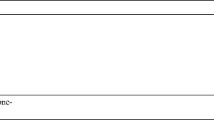Abstract
A model for analysis and visualization of asymmetric data—GIPSCAL—is reconsidered by means of the projected gradient approach. GIPSCAL problem is formulated as initial value problem for certain first order matrix ordinary differential equations. This results in a globally convergent algorithm for solving GIPSCAL. Additionally, first and second order optimality conditions for the solutions are established. A generalization of the GIPSCAL model for analyzing three-way arrays is also considered. Finally, results from simulation experiments are reported.
Similar content being viewed by others
References
Calvo M.P., Israels A., and Zanna A. 1996.Runge-Kutta methods for orthogonal and isospectral flows.Technical Report 1996/NA08, DAMTP, University of Cambridge.
Carroll J.D. and Chang J.J. 1970. Analysis of individual differences in multidimensional scaling via an n-way generalization of “Eckart-Young” decomposition. Psychometrika 35: 283-319.
Chino N. 1978. A graphical technique for representation asymmetric relationships between n objects. Behaviormetrika 5: 23-40.
Chu M.T. 1994. A list of matrix flows with applications. Fields Institute Communications 3: 87-97.
Chu M.T. and Driessel K.R. 1990. The projected gradient method for least squares matrix approximations with spectral constraints. SIAM J. Numer. Anal. 27: 1050-1060.
Chu M.T. and Trendafilov N.T. 1998. On a differential equation approach to the weighted orthogonal Procrustes problem. Statistics and Computing 8: 125-133.
Constantine A.G. and Gower J.C. 1978. Graphical representation of asymmetric matrices. Appl. Statist. 27: 297-304.
Diele F., Lopez L., and Peluso R. 1998. The Cayley transform in the numerical solution of unitary differential systems. Advances in Computational Mathematics 8: 317-334.
Edelman A., Arias T., and Smith S.T. 1998. The geometry of algorithms with orthogonality constraints. SIAM J. Matrix Anal. and Appl. 20: 303-353.
Engø K., Marthinsen A., and Munthe-Kaas H. 1997. DiffMan—an object oriented MATLAB toolbox for solving differential equations on manifolds (User's Guide). Available at http://www.math.ntnu.no/num/synode/.
Faddeev D.K. and Faddeewa W.N. 1963. Computational Methods of Linear Algebra. Freeman, San Francisco.
Gower J.C. 1977. The analysis of asymmetry and orthogonality. In: Barra J.R., Brodeau F., Romier G., and van Cutsem B. (Eds.), Recent Developments in Statistics. North Holland, Amsterdam, pp. 109-123
Harshman R.A. 1978.Models for analysis of asymmetrical relationships among N objects or stimuli. Paper presented at the First Joint Meeting of the Psychometric Society and the Society of Mathematical Psychology, Hamilton, Ontario, Canada
Harshman R.A., Green P.E., Wind Y., and Lundy M.E. 1982. A model for the analysis of asymmetric data in marketing research. Marketing Science 1: 205-242.
Harshman R.A. and Kiers H.A.L. 1987.Algorithms for DEDICOM analysis of asymmetric data. Paper presented at the European Meeting of the Psychometric Society, Enschede, The Netherlands.
Helmke U. and Moore J.B. 1994. Optimization and Dynamical Systems, Springer Verlag, London.
Hirsch M.W. and Smale S. 1974. Differential Equations, Dynamical Systems, and Linear Algebra. Academic Press, London.
Kelley C.T. 1999. Iterative Methods for Optimization. SIAM, Philadelphia
Kiers H.A.L. 1989.An alternating least squares algorithm for fitting the two-and three-way DEDICOM model and the IDIOSCAL model. Psychometrika 55:515-521.
Kiers H.A.L. 1990. Majorization as a tool for optimizing a class of matrix functions. Psychometrika 55:417-428.
Kiers H.A.L., ten Berge J.M.F., Takane Y., and De Leeuw J. 1990. A generalization of Takane's algorithm for DEDICOM. Psychometrika 55:151-158.
Kiers H.A.L. and Takane Y. 1994. A generalization of GIPSCAL for the analysis of nonsymmetric data, Journal of Classification 11: 79-99.
Krzanowski W.J. 1988. Principles of Multivariate Analysis: A User's Perspective. Clarendon Press, Oxford.
Lippert R.A. and Edelman A. 2000. Nonlinear eigenvalue problems with orthogonality constraints (Section 9.4). In: Bai Z., Demmel J., Dongarra J., Ruhe A., and van der Vorst H. (Eds.), Templates for the Solution of Algebraic Eigenvalue Problems: A Practical Guide, SIAM, Philidelphia, pp. 290-314.
Magnus J.R. and Neudecker H. 1988. Matrix Differential Calculus with Application in Statistics and Econometrics. Wiley, New York.
Ortega J.M. 1987. Matrix Theory: A Second Course. Plenum Press, New York.
Shampine L.F. and Reichelt M.W. 1997. The MATLAB ODE suite. SIAM Journal on Scientific Computing 18: 1-22.
Stiefel E. 1935/1936. Richtungsfelder und fernparallelismus in n-dimensionalel manning faltigkeiten. Commentarii Mathematici Helvetici 8: 305-353.
Stiefel E. 1963. An Introduction to Numerical Analysis. Academic Press, New York.
Takane Y. 1985. Diagonal estimation in DEDICOM. In Proceedings of the 1985 Annual Meeting of the Behaviormetric Society Sapporo. pp. 100-101.
Trendafilov N.T., De Moor B., and Cambré J. 1997. A projected gradient approach for analyzing asymmetric data. Technical Report, ESAT-SISTA/TR 1997-113, KULeuven. Available at http://www.mech.kuleuven.ac.be/∼ntrendaf.
Trendafilov N.T. and Murakami T. 1998. Orthonormality-constrained INDSCAL with nonnegative saliences. Full and off-diagonal fitting, Internal Report, PMA-KULeuven. Available at http://www.mech.kuleuven.ac.be/∼ntrendaf/pubs.htm.
Rights and permissions
About this article
Cite this article
Trendafilov, N.T. GIPSCAL revisited. A projected gradient approach. Statistics and Computing 12, 135–145 (2002). https://doi.org/10.1023/A:1014882518644
Issue Date:
DOI: https://doi.org/10.1023/A:1014882518644




